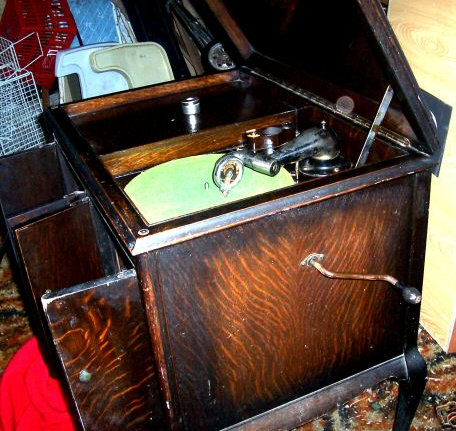The Victor-Victrola Page

Oak Finishes
About Oak Finishes: Victor produced cabinets in eight different oak finishes; some are quite commonly found, and others are considered to be unique and rare. Most external-horn Victor models were offered only in "oak" with no further description provided, but the shading of the cabinets and wood horns varied considerably from the factory, allowing the buyer to pick a machine which best matched their home decor. By 1905, a few external-horn models were offered in mahogany, but oak always remained the most popular choice. So there was not an "official" desciption of oak finishes for the external horn machines...whatever came off the production line was delivered to the dealer, and the buyer picked-out the shading they preferred.
Oak was not offered as an option for the earliest (1906-1907) internal-horn Victrola models. In 1908, a few different oak finishes were available, and by 1913, a total of eight oak finishes were listed as no-cost options. Oak was very commonly used on smaller tabletop Victrola machines (VV-IV, VV-VI, VV-VIII, etc.), but is slightly less common than mahogany on floor models.
Describing the eight different oak finish options is a complex task, and some disagreement exists within the collector community in properly identifying the exact oak finish used on a given machine. Oak is usually discernable by a "tiger-stripe" grain pattern. In addition most factory oak finishes are not as "mirror smooth" as mahogany or walnut, due the natural texture of the wood. The color and shading will vary greatly, even within the same type of oak finish, and there is much "overlap" of shades and contrasts, which can cause confusion, even amongst experts. These differences can often be clearly noted between different examples of the same model with the same finish due to the characteristics of a particular "batch" of oak veneer and its chemical and absorption properties when new. So a conciderable degree of variation is to be expected when evaluating an oak finish.
The photos below offer a typical representation of the original finishes.
Collectability: Oak finishes are not nearly as rare or valuable as Circassian Walnut or Amboyna Wood finishes, but some of the unusual oak finish options (noted below) are sought-after by collectors today. One factor in this determination of worth is how well the finish has survived the ravages of time; for example, many of the "shaded" oak styles such as Gunmetal Oak, Flemish Oak, or Driftwood Oak tended to fade after exposure to heat or direct sun over time, and may now appear as a bare oak cabinet. This is easily evaluated by looking under the lid or inside the doors, where the surfaces were protected, and determining what the original coloring was when new. A Victrola with a faded exterior (in any finish) will rarely be considered valuable, as most collectors want machines with an excellent original finish throughout. Machines in Golden Oak, Antique Oak, or Fumed Oak were originally produced in very high numbers, and will rarely have a higher valuation than a similiar model in mahogany.
Again, please bear in mind that there is a considerable overlap in the shading and amount of "gloss" in these finishes, and it can be a real challenge trying to determine the type of oak finish that was applied.
1. Golden Oak
Golden Oak was the most common oak finish for tabletop and floor Victrolas. It typically has a yellow-gold color with a "tiger stripe" pattern. There were considerable variations in colors and textures of this finish; some lean towards a yellow color, and others toward a brown, tan, or reddish hue. When producing Golden Oak, a dye stain was applied to the cabinet, allowed to dry, and a protective top-coat was then added. Buyers could choose from Golden Polished Oak (examples below left and center) with a highly polished varnish top-coat, or Golden Waxed Oak (example below right) which has a dull shellac surface covered by wax. Other finish coats were also offered. The extent of the color and surface finish variations are impossible to show on website photos. The vast majority of oak Victrolas, both tabletop and floor models, were produced in Golden Oak.
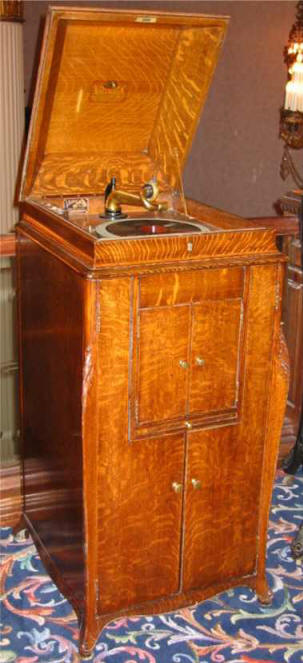
2. Antique Oak
Antique Oak can be very difficult to differentiate from Golden Oak, but has more contrasts and a slightly rougher, more textured finish. It has been sarcastically referred to as "dirty oak". Very few machines with this finish have been formally identified via documented invoices or ID tags on shipping crates, and some have speculated that Victor simply used the name "Antique Oak" to refer to the darker varieties of "Golden Oak" that came off the assembly line. Theoretically, Antique Oak, has dark-stained "crannies" in the wood grain to give a more worn appearance. However, this "antique" effect may simply be due to normal variations in the veneer's properties when new. There is often so much overlap with Golden Oak, that it can be nearly impossible to ascertain the correct finish. A clear differentiation of both types is shown below. Antique Oak on the left and Golden Oak on the right. Most examples fall in-between these two extremes.
3. Fumed Oak
Fumed Oak also causes a great deal of confusion in the hobby. "Fuming" is the process of placing the oak cabinet in an ammonia bath, which darkens the wood and brings out the grain contrast. The wood typically turns tan or brown. Since a chemical reaction occurs within the oak veneer during fuming, it creates a naturally "hard" surface which does not require subsequent coats of varnish or shellac. This was a very popular choice in the early years of the 20th Century, and was very economical to produce. The longer the cabinet sat in the ammonia fumes, the darker it would become. Fuming was a major production operation in the Victor Cabinet factory, and many oak machines went through this process.
Even amongst wood-finishing experts, it can be difficult to determine a fumed finish from a stained finish, and many collectors have been baffled as to what type of finish a particular machine may have. On Fumed Oak machines where the cabinet was left in the fume-bath for many hours (below left), the results are very obvious. It is very dark brown, with subtle hints of grain contrasts. However, with less time in the bath (below right), the results can be remarkably similar to some of the darker examples of Golden Oak. A recent article was published in a woodworking magazine where samples of a fumed finish and a dye-stained finish were placed in front of several experienced furniture restorers in a comparison test, and the results were totally indeterminate. Most could not accurately differentiate between the two types of finishes. We know for certain that the example on the right (below) is a Fumed Oak finish because this particular model was only available with this finish choice.
Fumed Oak is normally brown (not yellow) in color, and will rarely have a top-coat of varnish, although many exceptions have been identified.
4. Weathered Oak
Weathered Oak was also a popular choice for Victrola buyers. The wood veneer was not sanded as extensively as was done for other finishes, and the cabinets were then fumed for an pre-determined period of time, resulting in a beautiful grain contrast and somewhat "craggy" weathered appearance (below, left). Some examples models featured spectacular grain figuring and contrasts (below, right). Weathered Oak is similar to dark Fumed Oak, but the surface textures are different.
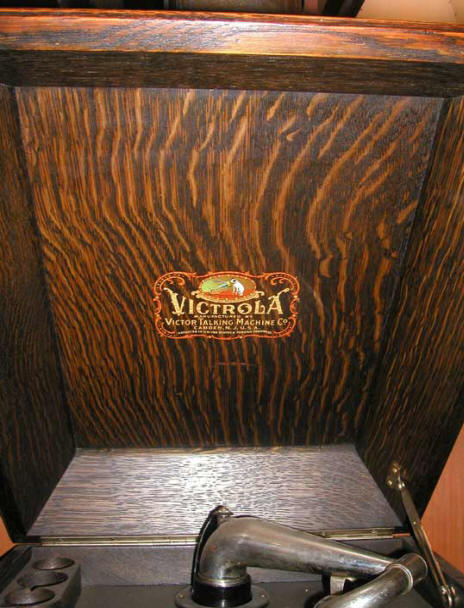
5. Flemish Oak
Flemish Oak machines have a "virtually black" appearance, with virtually no contrast in the grain, excepting for the texture. It was produced by applying a black dye over the wood cabinet, and then fuming it for an extended period of time. This black finish tended to fade over time due to sun or heat exposure, and many worn examples now have the external appearance of plain Fumed Oak. When new, very little brown color showed through the black finish.
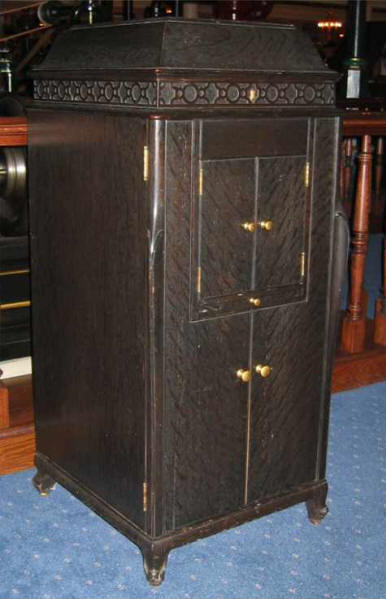
6. Early English Oak
Early English Oak is simply Weathered Oak with a glossy varnish overcoat (below).
7. Driftwood Oak
Driftwood Oak is a rare finish, with a lightly fumed-brown base color and the grey shades of ocean driftwood inside the grain "crannies". As with Flemish Oak, this finish typically did not survive well when stored in high-heat conditions (attics) and tended to fade-away to pure brown. The original appearance would have been as shown below right, with an example showing some wear to the external portions of the cabinet as seen below left. The exact processes that were used to produce this finish are unknown, but are assumed to be fumed, and later coated with a grey dye with a subsequent finish "rub-out" to achieve this remarkable appearance.
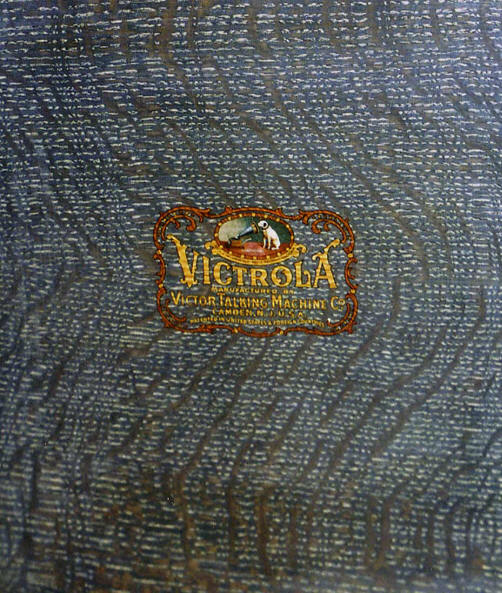
8. Gunmetal Oak
Gunmetal Oak is also a very rare finish, with a dark patina-grey grain coloration in the grain "crannies", similar to what would be found on an old gun barrel. No documented survivors of this finish have been found, but it is assumed that, like Driftwood Oak, it tended to fade-out over time, and would eventually have the appearance of brown Fumed Oak. An example of Gunmetal Oak (from the Victor Cabinet Dealer Display Sampler) is shown below.
Antique Italian Oak
Antique Italian Oak was not a standard oak finish in the Victor catalog, but was produced from 1924-1925 in an attempt to improve the sagging sales of some models. It is characterized by strongly contrasting shades with a light center and dark surround, and a very dominant wood grain.
